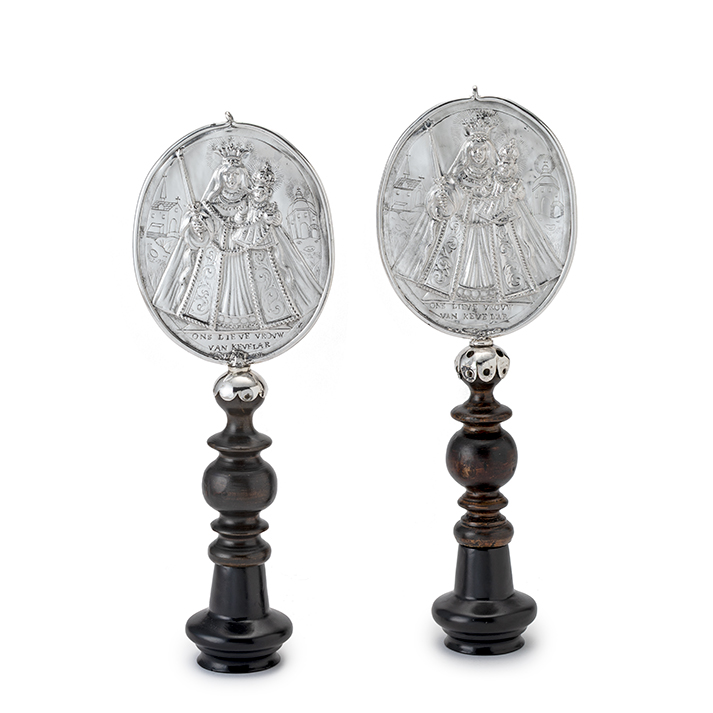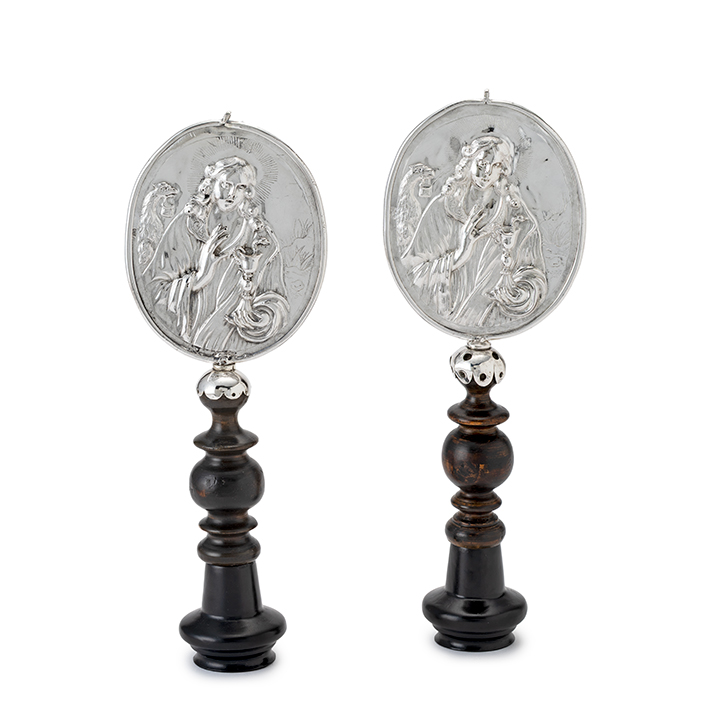
Pair of silver processional plaques
About This Project
Pair of silver processional plaques of ‘our lady Kevelaar’
Jacobus Smits
(Den Bosch) circa 1725
239 grams in total, 12.3 cm high, approx. 10.2 cm wide, height with wooden stand 23-23.5 cm
The plaques are chased at the front and back and mounted against each other with a border. The obverse with the image of Mary, Comforter of the afflicted, the reverse with the image of the apostle John with chalice, serpent and eagle. The processional plaques are placed on wood baluster-shaped stems. Both plaques are marked with only the maker’s mark on the mounted border.
The maker’s mark of the silversmith Jacobus Smits was struck on 1 December 1710, number 115 on the insculpation plate by the gold and silversmiths’ guild of Den Bosch. From 1680 to 1681 Jacobus was apprenticed to the silversmith Adriaen van Laer from Den Bosch. He was an assaymaster of the guild for 2 years and worked until about 1731. He died in 1731 or 1732. Jacobus Smits must have been a productive silversmith. Various ecclesiastical objects are known from him, including a censer, incense ship, ciborium, monstrance, chalice, sanctuary lamp, exposition throne and a few church candlesticks. These silver objects are all dated between 1713 and 1725.
The processional plaques were placed on wooden poles and carried in the procession of believers who went on a pilgrimage from their homes to Kevelaar. These Roman Catholic brotherhoods are located in various places in the Netherlands. One of the oldest, the brotherhood of the procession to Our Lady of Kevelaar, was founded in 1692 in Amsterdam. There was also a brotherhood in Den Bosch, which was founded in 1724 and was linked to the parish of St Petrusbanden. Most brotherhoods were formally dissolved in 1992 to later form one large brotherhood in the Netherlands. There are still annual trips to Kevelaar from the various Roman Catholic dioceses.
The German town of Kevelaer (just across the border near Venlo) has been a well-known Marian pilgrimage site for centuries. Since 1642, a miraculous statue of the Virgin Mary has been venerated in this place. This image of grace is known as the ‘Consolatrix Afflictorum’: the ‘Comforter of the afflicted’. In 1641, the travelling salesman Hendrick Busman was on his way from Weeze to Geldern and was praying at the hail cross at a junction near the hamlet of Kevelaer, when he heard a call from Mary three times: “You must build a chapel for me on this spot!” Busman was a poor man, however, the chapel was built in 1642. Pilgrims soon followed and so did the first healings. In 1647, the Church recognized eight of these healings as miraculous. The Chapel of Mercy was built around the original stone prayer column in 1654, a few years earlier a pilgrimage church had already been built. In the nineteenth century, the large St. Mary’s Church was built, which was upgraded to a basilica in 1923.
For more information, click here




